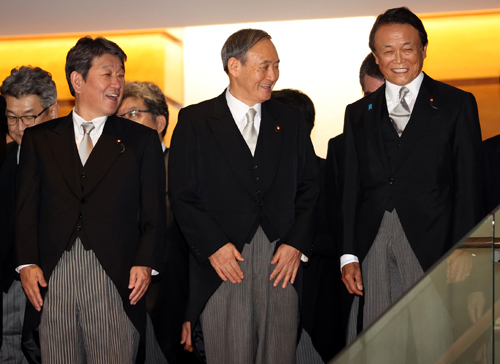Arrows that missed the target
View(s):
Newly appointed Japanese Prime Minister Yoshihide Suga with Finance Minister Taro Aso (R) and Foreign Minister Toshimitsu Motegi (L) smile as they prepare for a photo session with other cabinet members at the prime minister's official residence in Tokyo, Japan September 16, 2020. Yoshikazu Tsuno/Pool via REUTERS
In 2011, the US dollar was traded for 75 Japanese yen – the lowest yen-dollar exchange rate ever existed. This means a Japanese exporter received 75 yen for each dollar he earned from abroad. About 40 years ago, the same exporter would have received 350 yen for each dollar! Japanese currency – yen -, was one of the most appreciating currencies in the world. Since the early 1970s when Japan adopted a flexible exchange rate system, the external value of the yen has appreciated consistently.
The deliberate policy efforts since 2012 were successful in forcing the Japanese yen to depreciate moderately to reach 110 yen per dollar and maintained it throughout till 2020. However, it was just like a little paracetamol pill to a chronic illness. Depreciation of the yen didn’t add much to rescue the Japanese economy from its deep-rooted stagnation. Neither did the appreciating yen harm the strong export growth that Japan had already achieved under a highly “undervalued” exchange rate system prior to 1970s.
Prime Minister of Japan, Shinzo Abe, resigned a few weeks ago after serving in office for over seven years – the longest period of term in office that a Prime Minister in Japan has ever served. Since the day he assumed in office in 2012, he had a mission to accomplish – to get the Japanese economy out of its deep recession. Was he able to accomplish his mission?
Today, let’s shed some light on this issue – a problem of a rich country, which looks entirely different from a developing country perspective. It is because “achieving prosperity” is one thing, but “managing prosperity” is another thing.
Joining the first world
Japan was the first country in Asia to leave all its poverty-stricken Asian neighbours at the time to join the “first world” which was in the Western Hemisphere. After the Second World War, war-ridden Japan focused exclusively on its development issue. The security issue of the country was largely a responsibility of the US under an agreement between the two nations. It helped Japan to become the world’s first-ever fastest-growing economy, sustaining annually on average about 10 per cent rate of economic growth from late 1940s to early 1970s.
In terms of per capita income, Japan surpassed the UK in the 1970s and even the US in the 1980s. Then, its decades of miraculous economic growth ended and Japan suddenly entered a long-term stagnation in the early 1990s. The annual rate of economic growth fell closer to zero level, while sometimes it fell even below zero as well. The rate of unemployment rose from around 2 per cent of the labour force and sometimes exceeded 5 per cent. The rate of inflation remained around zero and, often fell below zero leading to deflationary expectations.
In spite of long-term recession, Japan didn’t have a shortage of foreign exchange even if its trade surplus was hit by the appreciating currency. Foreign exchange inflows were guaranteed by the increasing foreign demand for Japanese bonds. Excess demand for bonds drove up the bond prices and drove down the interest rates. But the appreciating currency ensured the profitability of investment in bonds, which also contributed to Japan’s high debt.
Economics looks crazy
If a person consumes less and saves more, he will have a better life in the future, as we all tend to believe. But this may not be true always. What is true for individuals is not necessarily true for nations – the so-called “fallacy of composition”. If a nation consumes less and saves more, it might not work for good, which is at the heart of the Japanese economic problem.
Among other contributory factors, one of the strongest explanations to Japanese economic recession rests upon the above issue – lower household consumption, causing higher levels of savings, which also drive down the interest rates. Japan’s household expenditure remains lower, and domestic saving remains higher, than their average for high-income countries.
Inflation rate around zero per cent and sometimes turning to deflation is worse than having some inflation. With “inflationary expectations”, people advance their spending, actually, causing inflation to rise. On the other hand, with “deflationary expectations”, we should expect the opposite: People tend to postpone their spending, which, in fact, explains part of the lower household expenditure pattern too. Postponing household spending pushes the prices further down, resulting in deflation.
In an inflationary situation, long-term interest rates should rise as demand for bonds should fall. In contrast, in a deflationary situation, demand for bonds should rise in order to accommodate higher savings so that interest rates should fall – another factor underlying lower interest rates and higher public debt.
“Abenomics”
In comes the new Prime Minster Shinzo Abe in 2012 with a promise and an aggressive economic policy package known as “Abenomics” to revive the Japanese economy. As it was explained at that time, this economic policy package comprised three “arrows” to hit the target: Monetary stimulus, fiscal stimulus and structural reforms.
The first two arrows, monetary and fiscal stimuli were aimed at stimulating aggregate demand, as typical policy measures in economic recessions. Money printing and unconventional measure of “quantitative easing” – buying back the stocks of long-term bonds were adopted by the Central Bank in order to make money plenty and credit attractive. Flooding the market with money was combined with fiscal policy stimulus – increased government spending on welfare and public works and providing tax incentives for businesses. The policy makers anticipated through these two arrows that both consumers and investors will stimulate spending so that production would revive, and deflationary fear would come to an end.
 Arguably the most important arrow was the third one – structural reforms. This was aimed at increasing production and productivity through a series of supply-side policy measures. These regulatory reforms included corporate tax reforms, women’s role in labour force, opening for foreign skilled-labour, tourism revival, and relaxing regulatory barriers for trade and investment.
Arguably the most important arrow was the third one – structural reforms. This was aimed at increasing production and productivity through a series of supply-side policy measures. These regulatory reforms included corporate tax reforms, women’s role in labour force, opening for foreign skilled-labour, tourism revival, and relaxing regulatory barriers for trade and investment.
While the first two arrows were aimed at achieving “short-term” objectives, the third arrow was to establish the fundamentals for “long-term” economic progress. Even by implementation, the first two arrows were aggressive, but the third one continued to remain a more difficult policy choice because it was aimed at correcting structural rigidities. And even without the third arrow, it was apparently a difficult policy target to get the economy out of stagnation.
Key issue
The achievements were “piecemeal” in nature as there were sporadic outcomes here and there, but, Abenomics, as a whole, doesn’t seem to have worked up to expectations. Except for halting exchange rate appreciation, in most of the other areas of importance, the Japanese economy did not show much difference from what it had prior to 2012.
Over the past seven years (2013-2019), average rate of GDP growth remained at 1 per cent, although there was a surge in annual rate of growth to 2 per cent initially in 2013. Average rate of inflation remained less than 1 per cent, even though it was expected to achieve 2 per cent rate of inflation through monetary and fiscal stimuli. Exports of goods and services still remain less than 20 per cent of GDP, compared to over 40 per cent in Germany and over 30 per cent in the UK.
The third arrow – structural reforms, is the key issue which was not possible to push forward as aggressively as the first two arrows. Above all, even what has been achieved in the past didn’t come to a completion due to the COVID-19 pandemic issue which hit the Japanese economy hard. The economy contracted by 1.8 per cent in the first quarter, and by 10 per cent in the second quarter of 2020. And after all, it is sad enough, the years of preparations for “Olympic 2020” too faded away due to the same issue. (The writer is a Professor of Economics at the University of Colombo and can be reached at sirimal@econ.cmb.ac.lk and follow on Twitter @SirimalAshoka).


